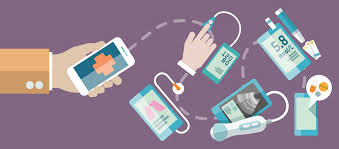 An event for health tech vendors to reach other health tech vendors. This event is an odd mix of technology service providers, health tech vendors (multiple categories), and startups looking to engage from a business partnership, channel, solution set perspective. The event was preceded earlier in the year with a post about the Top Five Tech Trends in Healthy Longevity which include: Virtual Assistants, Virtual Coaching for Chronic Conditions, Caregiver Apps and Social Networks, Social Robots, and Virtual Reality. And there were a number of exhibitors at the event that reinforced that trend list – some noted in previous blog posts. All material sourced from company information:
An event for health tech vendors to reach other health tech vendors. This event is an odd mix of technology service providers, health tech vendors (multiple categories), and startups looking to engage from a business partnership, channel, solution set perspective. The event was preceded earlier in the year with a post about the Top Five Tech Trends in Healthy Longevity which include: Virtual Assistants, Virtual Coaching for Chronic Conditions, Caregiver Apps and Social Networks, Social Robots, and Virtual Reality. And there were a number of exhibitors at the event that reinforced that trend list – some noted in previous blog posts. All material sourced from company information:
FallCall Solutions. "ElderCheck Now: an application that was exclusively designed for iPhone® and Apple Watch®. When installed on both caregiver and elder devices, ElderCheck Now has the ability for a caregiver to maintain contact with their loved one any time of day through simplified, intuitive check-in screens right on a loved one’s wrist, or on their nearby iPhone. What’s even better: after initially purchasing ElderCheck Now, there are NO SUBSCRIPTION FEES! Caregivers can check-in as many times as they want…Elders can respond as much as they want. Whatever the situation, ElderCheck Now can be that extra link when you can’t be by someone’s side." Learn more at ElderCheckNow from FallCall Solutions.
PilloHealth. lPillo is an intelligent home health companion robot that can manage your medications, answer your medical questions, re-order medications, send notifications to family members when medications are missed, and connect you directly with doctors. Using the latest in voice and facial recognition technologies, Pillo can hear, see and understand you. This enables him to adapt his functionalities to serve your specific needs. And to ensure that your supplements, medication, and personal data are all totally secure." Learn more at PilloHealth.
PropelHealth. "Propel Health is in the 'Personal Connected Health and Wellness Business' and there has never been a better time to lead the transformation to create empowered health and wellness for individuals. While most of the 'healthcare' industry focuses their investment and innovation on an individual 'in the healthcare system' very few are focused on creating an empowered, proactive, connected experience to help keep the individual 'out of the system' – when they are striving to be healthy, manage a chronic illness, recover from an in-patient procedure or are between doctor visits. With personalized Body Area Networks of wearables and Smart Personal Area Network of environmental sensors in the home, you can create an environment that keeps you well and engages your love and support team to help when things move out of your defined thresholds." Learn more at PropelHealth.net.
Rendever. Co-founded by Reed Hayes, Dennis Lally and Tom Neumann, Rendever is a startup that strives to bring virtual technology to older adults. The co-founders explained that they hope to not only give the elderly virtual experiences they might be incapable of having in reality, but also give them a better quality of life." At Connected Health here is the description: "Rendever provides a turnkey virtual reality platform for improving patient experience and outcomes. With group sync technology and external tablet controls, the Rendever platform is the most user-friendly way to allow patients and residents to experience the benefits of virtual reality through distraction therapy, cognitive stimulation and social engagement." Learn more at Rendever.
VRPhysio – a Virtual Reality Physical Therapy Platform. "VRPhysio™ is a VR rehabilitation software that provides a captivating experience for patients of any age, designed to stimulate people to perform specific movements while serving as an accurate tracking tool for physical therapists. VRPhysio™ includes a series of full body exercises suitable for physical rehabilitation treatment, both at the clinic and at home. Utilizing real-time data analysis based on advanced algorithms, the program generates progress reports containing high-resolution metrics on improvement. VRPhysio™ transforms patients' exercises to a fun and engaging experience while their PT monitors their adherence and outcomes. Such insights into patient performance over time, both in the clinic and at home, enable precise analysis and adjusting treatment regimens." Learn more at VRHealthgroup.
from Tips For Aging In Place https://www.ageinplacetech.com/blog/five-technology-offerings-older-adults-connected-health-boston-2017
 October is a busy month of events, new research and announcements. All are back from vacation,
October is a busy month of events, new research and announcements. All are back from vacation,  When boomers are 84 – there will be no keeping up. Just the same as when they are 64. Many boomers disagree with that statement, finding it insulting or pessimistic or both. They will repeat plaintively that baby boomers are very different than their parents’ generation. They are comfortable with technology. See how many have smartphones! They text, use Facebook and YouTube. Many
When boomers are 84 – there will be no keeping up. Just the same as when they are 64. Many boomers disagree with that statement, finding it insulting or pessimistic or both. They will repeat plaintively that baby boomers are very different than their parents’ generation. They are comfortable with technology. See how many have smartphones! They text, use Facebook and YouTube. Many